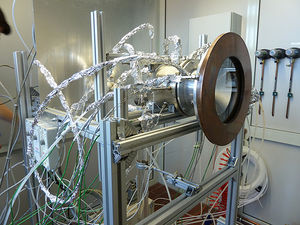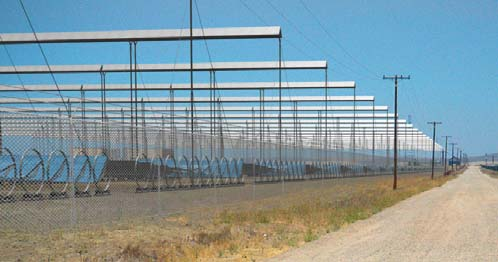Solar Thermochemistry: Difference between revisions
Jump to navigation
Jump to search

(+image) |
|||
| Line 1: | Line 1: | ||
[[File:Solar_reactor.jpg|300px|thumb|right|Solar reactor in the [http://www.sollab.eu/psi.html lab] of Prof. Aldo Steinfeld und doctoral student Philipp Furler at ETHZ (Zurich, Switzerland). This lab has done a lot of work on solar thermochemistry, including the [[Solar Upgrading of Hydrocarbons|solar upgrading of hydrocarbons]]. ]] | [[File:Solar_reactor.jpg|300px|thumb|right|Solar reactor in the [http://www.sollab.eu/psi.html lab] of Prof. Aldo Steinfeld und doctoral student Philipp Furler at ETHZ (Zurich, Switzerland). This lab has done a lot of work on solar thermochemistry, including the [[Solar Upgrading of Hydrocarbons|solar upgrading of hydrocarbons]]. ]] | ||
[[File:Ausra field.png|498px|thumb|right|Ausra-type solar concentrator. Potential collector for solar process heat. ]] | |||
Thermochemistry is the study of heat flow to or from a chemical reaction. '''Solar''' thermochemistry is an emerging process technology that uses concentrated solar energy to drive endothermic chemical reactions at elevated temperatures. | Thermochemistry is the study of heat flow to or from a chemical reaction. '''Solar''' thermochemistry is an emerging process technology that uses concentrated solar energy to drive endothermic chemical reactions at elevated temperatures. | ||
Revision as of 00:43, 24 July 2016

Solar reactor in the lab of Prof. Aldo Steinfeld und doctoral student Philipp Furler at ETHZ (Zurich, Switzerland). This lab has done a lot of work on solar thermochemistry, including the solar upgrading of hydrocarbons.
Thermochemistry is the study of heat flow to or from a chemical reaction. Solar thermochemistry is an emerging process technology that uses concentrated solar energy to drive endothermic chemical reactions at elevated temperatures.
Applications
- production of carbon-neutral fuels (examples: water splitting or solar upgrading of hydrocarbons)
- solar metallurgy
- dissociation reactions, e.g. zinc (project: "SOLZINC")
- purification reactions
- A photogalvanic device is a type of battery in which the cell solution (or equivalent) forms energy-rich chemical intermediates when illuminated
- Photoelectrochemical cells or PECs consist of a semiconductor, typically titanium dioxide or related titanates, immersed in an electrolyte.
Related pages on OSE Wiki
Metal Refining, Heliostat, Solar metallurgy, Solar Upgrading of Hydrocarbons
